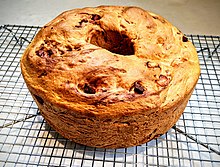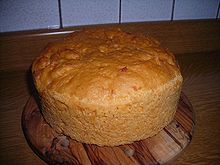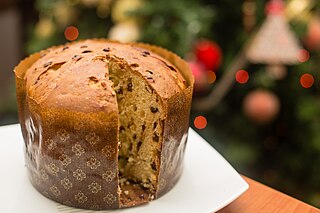
Panettone is an Italian type of sweet bread and fruitcake, originally from Milan, usually prepared and enjoyed for Christmas and New Year in Western, Southern, and Southeastern Europe, as well as in South America, Eritrea, Australia, the United States and Canada.

Focaccia is a flat leavened oven-baked Italian bread. In some contemporary places, such as Rome, it is a style of pizza, also called pizza bianca. Focaccia may be served as a side dish or as sandwich bread and it may be round, rectangular, or square shape.

Fruitcake or fruit cake is a cake made with candied or dried fruit, nuts, and spices, and optionally soaked in spirits. In the United Kingdom, certain rich versions may be iced and decorated.

Pastiera napoletana is a type of Neapolitan tart made with cooked wheat, eggs, ricotta cheese, and flavoured with orange flower water. It is usually eaten at Easter.

Paska is a Ukrainian Easter bread. It is particularly spread in Central and Eastern Europe, and countries with cultural connections to the ancient Byzantine Empire, Eastern Orthodoxy or Eastern Catholicism. Easter breads are a traditional element in the Easter holidays of Armenia, Belarus, Bulgaria, Croatia, Georgia, Moldova, Romania, Russia, Poland, Slovakia and Ukraine. It is also a common tradition amongst the Assyrian-Chaldean-Syriac diaspora. It is also eaten in countries with large immigrant populations from Central and Eastern Europe such as the United States, Canada and the United Kingdom.

Cozonac or Kozunak is a sweet yeast dough that can be used to make different traditional holiday breads and cakes. Often mixed with raisins, it can be baked as a loaf or rolled out with fillings like poppy seed or walnuts. It is common throughout Southeastern Europe in countries such as Romania, Moldova, Bulgaria, Serbia, North Macedonia and Greece. Rich in eggs, milk and butter, it is usually prepared for Easter in Romania, Serbia, Bulgaria, and in Romania and Moldova it is also traditional for Good Friday, in a simplified version with vegan ingredients, without eggs or milk - named Cozonac de post - to be eaten by Christians during lent. The name comes from the Bulgarian word for hair-коса/kosa, or Greek: κοσωνάκι, romanized: kosōnáki, a diminutive form of κοσώνα, kosṓna.

Colomba pasquale or colomba di Pasqua is an Italian traditional Easter bread, the Easter counterpart of the two well-known Italian Christmas desserts, panettone and pandoro.

Neapolitan cuisine has ancient historical roots that date back to the Greco-Roman period, which was enriched over the centuries by the influence of the different cultures that controlled Naples and its kingdoms, such as that of Aragon and France.

The poppy seed roll is a pastry consisting of a roll of sweet yeast bread with a dense, rich, bittersweet filling of poppy seed. An alternative filling is a paste of minced walnuts, or minced chestnuts.
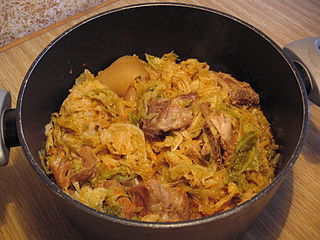
Lombard cuisine is the style of cooking in the Northern Italian region of Lombardy. The historical events of its provinces and of the diversity of its territories resulted in a varied culinary tradition. First courses in Lombard cuisine range from risottos to soups and stuffed pasta, and a large choice of second course meat or fish dishes, due to the many lakes and rivers of Lombardy.

The holiday of Easter is associated with various Easter customs and foodways. Preparing, coloring, and decorating Easter eggs is one such popular tradition. Lamb is eaten in many countries, mirroring the Jewish Passover meal.

The pizza di Pasqua, in some areas also called crescia di Pasqua, torta di Pasqua, torta al formaggio or crescia brusca, is a leavened savory cake typical of many areas of central Italy based on wheat flour, eggs, pecorino and Parmesan. Traditionally served at breakfast on Easter morning, or as an appetizer during Easter lunch, it is accompanied by blessed boiled eggs, ciauscolo and red wine or, again, served at the Easter Monday picnic. Having the same shape as panettone, the pizza di Pasqua with cheese is a typical product of the Marche region, but also Umbrian. There is also a sweet variant. The peculiarity of this product is its shape, given by the particular mold in which it is leavened and then baked in the oven: originally in earthenware, today in aluminum, it has a flared shape.
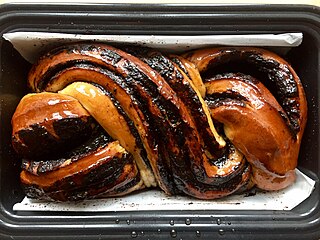
A babka is a sweet braided bread which originated in the Jewish communities of Poland and Ukraine. It is popular in Israel and in the Jewish diaspora. It is prepared with a yeast-leavened dough that is rolled out and spread with a filling such as chocolate, cinnamon, fruit, or cheese, then rolled up and braided before baking.
Easter cakes are cakes prepared and served during the Easter season. Sharing a cake with family for Easter is an Easter tradition in many denominations and countries.
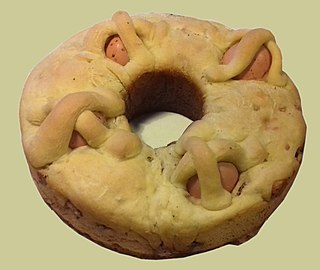
Casatiello is a leavened savory bread originating from Naples prepared during the Easter period.

Easter in Italy is one of the country's major holidays. Easter in Italy enters Holy Week with Palm Sunday, Maundy Thursday, Good Friday and Holy Saturday, concluding with Easter Day and Easter Monday. Each day has a special significance. The Holy Weeks worthy of note in Italy are the Holy Week in Barcellona Pozzo di Gotto and the Holy Week in Ruvo di Puglia.


